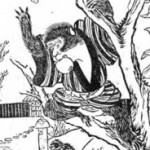I’m working on a KeyPoint presentation (PowerPoint for those of you PC people) on the Heian Period of Japan. I have been exploring temples and shrines. Originally built in the seventh century, it is an oldie but a goodie. There is an 11-faced statue of the Goddess of Mercy, Kannon, which was added in the eighth century by Emperor Shōmu. By the way, he seems to of been the first egalitarian Emperor because he married a non-royal commoner. Of course she was of a… Continue reading →
HASEDERA TEMPLE IN NARA AND ITS SUPERSTITIONS




